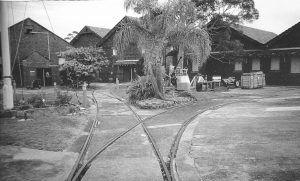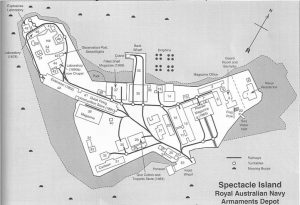- Author
- Haynes, Fred
- Subjects
- History - general
- Tags
-
- RAN Ships
- None noted.
- Publication
- September 2017 edition of the Naval Historical Review (all rights reserved)
By Fred Haynes
Spectacle Island is located near the suburb of Drummoyne at the confluence of Iron Cove and Parramatta rivers. It was originally named Dawes Island when surveyed in the weeks after the arrival of HMS Sirius, after Lieutenant William Dawes who was a Marine officer in Sirius. He was also a skilful surveyor and engineer and competent astronomer. The name ‘Spectacle’ came later when introduced by the artist and mapmaker John Skinner Prout in 1850. He remarked that at low tide it had the appearance of a pair of spectacles, being two small rocky islands connected by a rock platform visible at low tide. In 1860 the Colonial government proposed to develop an explosive magazine store at Spectacle Island.
The first building, erected between 1863 and 1865, was a sandstone powder magazine on the larger eastern island. Labour was initially provided using convicts from nearby Cockatoo Island with sandstone readily available from construction of the Fitzroy Dock. Towards the end of this period the convicts were relocated to the new Darlinghurst Prison and as a result civilian contractors were engaged to complete construction of the magazine. The island quickly became crowded with other buildings; most were designed by the Colonial architect, James Barnet.
With the advent of the new facilities at Spectacle Island the explosives magazines facilities on Goat Island closed in about 1864, because they were considered too close to the growing city. By 1884 all other Royal Naval stores held at Goat Island had also been transferred to Spectacle Island.
The Railway
A laboratory was built on the western island around 1878 and a causeway to connect the two islands was gradually built up by the dumping of spoil from the levelling of the larger island. A tramway of wooden rails was laid on the causeway.
The standard gauge railway system was expanded in the late nineteenth century and iron rails replaced the original wooden ones. Most of the buildings and wharves on the island were connected by rail with turntables, which are still used today to move heavy objects around the island. Manpower was employed to move the trolleys around the island, although with the use of forklifts on the island sometimes heavy loads are now towed to buildings. However in some buildings the modern forklift will not fit through the internal doorways.

While the rails are made of iron in most of the more modern buildings, the rails in the original magazine explosive buildings are still of wood, some above ground and others set into the floor. Of the 21 wooden trolleys (known as drugs) still existing on the island, there are several designs with flanged iron wheels and others have wheels made from delta metal. The latter were used in explosive buildings with iron rails, this prevented any possibility of sparks which could have disastrous consequences.

Spectacle Island today
After about one hundred years of service the armaments depot on Spectacle Island closed in the 1960s. It followed the same fate as Goat Island, this time being too close to the expanding residential areas of Balmain and Drummoyne. The Navy had also adopted more demanding NATO regulations for munitions storage. The explosives were transferred further up the Parramatta River to the Royal Australian Navy Armament Depot (RANAD) at Newington. It is ironic that Newington suffered the same fate and closed when much of the site was absorbed into Sydney’s Olympic precinct in time for the 2000 Games.
Currently Spectacle Island is the home of the RAN Heritage Collection and is a repository for many of the Navy’s heritage artifacts. When ships or establishments decommission, selected items are sent for storage. Items include relics from the ship and presentations such as silverware and trophies that have been awarded, called PR&T for short. The Sealed Pattern Collection provides examples of housekeeping items issued to ships. Each item had a tag with a description and an ID number, attached with a lead seal. The item then became an example when a new supply was required. This collection was originally held at the Royal Edward Victualling Yard (REVY) at Pyrmont. The Naval Cadet unit TS Sydney is also housed on the Island together with all the facilities required to support them.
Further reading on Spectacle Island is to be found in an article from the NHR of March 1976 – www.navyhistory.au see Home page then Search for Spectacle Island.




